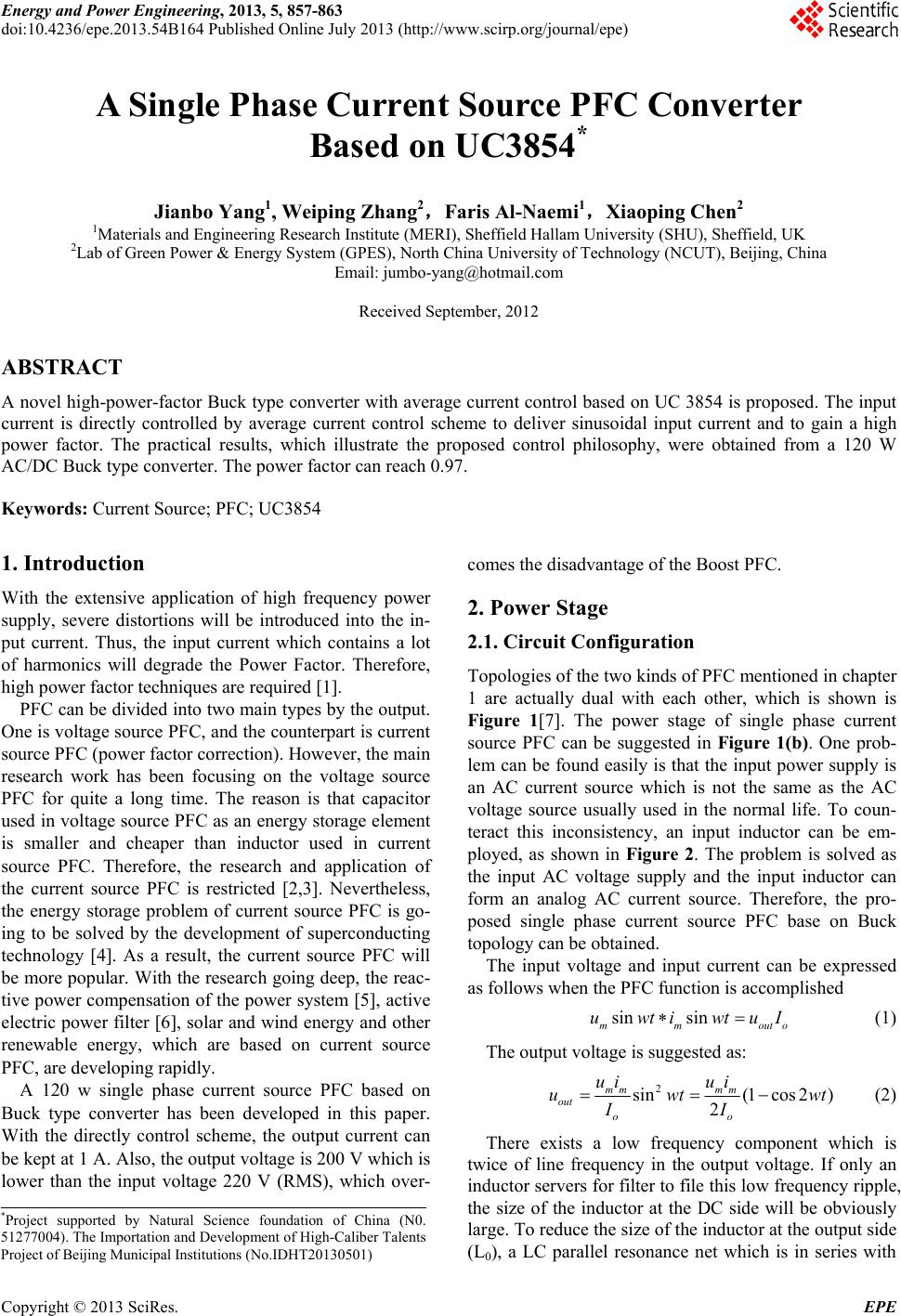
Energy and Power Engineering, 2013, 5, 857-863
doi:10.4236/epe.2013.54B164 Published Online July 2013 (http://www.scirp.org/journal/epe)
A Single Phase Current Source PFC Converter
Based on UC3854*
Jianbo Yang1, Weiping Zhang2,Faris Al-Naemi1,Xiaoping Chen2
1Materials and Engineering Research Institute (MERI), Sheffield Hallam University (SHU), Sheffield, UK
2Lab of Green Power & Energy System (GPES), North China University of Technology (NCUT), Beijing, China
Email: jumbo-yang@hotmail.com
Received September, 2012
ABSTRACT
A novel high-power-factor Buck type converter with average current control based on UC 3854 is proposed. The input
current is directly controlled by average current control scheme to deliver sinusoidal input current and to gain a high
power factor. The practical results, which illustrate the proposed control philosophy, were obtained from a 120 W
AC/DC Buck type converter. The power factor can reach 0.97.
Keywords: Current Source; PFC; UC3854
1. Introduction
With the extensive application of high frequency power
supply, severe distortions will be introduced into the in-
put current. Thus, the input current which contains a lot
of harmonics will degrade the Power Factor. Therefore,
high power factor techniques are required [1].
PFC can be divided into two main types by the output.
One is voltage source PFC, and the counterpart is current
source PFC (power factor correction). However, the main
research work has been focusing on the voltage source
PFC for quite a long time. The reason is that capacitor
used in voltage source PFC as an energy storage element
is smaller and cheaper than inductor used in current
source PFC. Therefore, the research and application of
the current source PFC is restricted [2,3]. Nevertheless,
the energy storage problem of current source PFC is go-
ing to be solved by the development of superconducting
technology [4]. As a result, the current source PFC will
be more popular. With the research going deep, the reac-
tive power compensation of the power system [5], active
electric power filter [6], solar and wind energy and other
renewable energy, which are based on current source
PFC, are developing rapidly.
A 120 w single phase current source PFC based on
Buck type converter has been developed in this paper.
With the directly control scheme, the output current can
be kept at 1 A. Also, the output voltage is 200 V which is
lower than the input voltage 220 V (RMS), which over-
comes the disadvantage of the Boost PFC.
2. Power Stage
2.1. Circuit Configuration
Topologies of the two kinds of PFC mentioned in chapter
1 are actually dual with each other, which is shown is
Figure 1[7]. The power stage of single phase current
source PFC can be suggested in Figure 1(b). One prob-
lem can be found easily is that the input power supply is
an AC current source which is not the same as the AC
voltage source usually used in the normal life. To coun-
teract this inconsistency, an input inductor can be em-
ployed, as shown in Figure 2. The problem is solved as
the input AC voltage supply and the input inductor can
form an analog AC current source. Therefore, the pro-
posed single phase current source PFC base on Buck
topology can be obtained.
The input voltage and input current can be expressed
as follows when the PFC function is accomplished
sin sin
mmout o
uwtiwtuI
(1)
The output voltage is suggested as:
2
sin(1cos 2)
2
mm mm
out oo
ui ui
uwt
II
wt
(2)
There exists a low frequency component which is
twice of line frequency in the output voltage. If only an
inductor servers for filter to file this low frequency ripple,
the size of the inductor at the DC side will be obviously
large. To reduce the size of the inductor at the output side
(L0), a LC parallel resonance net which is in series with
*Project supported by Natural Science foundation of China (N0.
51277004). The Importation and Development of High-Caliber Talents
Project of Beijing Municipal Institutions (No.IDHT20130501)
Copyright © 2013 SciRes. EPE